Uncover Greece’s Hidden Gems: Explore ancient ruins, cultural treasures, and lesser-known islands for a journey off the beaten path. Greece’s authentic soul.
Greece, renowned for its ancient ruins and iconic islands, holds a treasure trove of hidden gems awaiting discovery. Beyond the well-trodden paths, lesser-known destinations and attractions offer a glimpse into Greece’s authentic charm. From secluded islands and ancient secrets to hidden villages and natural wonders, this blog uncovers the off-the-beaten-path treasures that often escape the radar of tourists. If you are like me, I try to escape the tourists and love unique places.
Content
- Introduction
- Why Greece is an Excellent Destination for Off-the-beaten-path Adventures
- Unveiling 6 Lesser-Known Islands
- Ancient Secrets Revealed
- 7 Hidden Villages and Mountain Retreats
- Natural Wonders and Outdoor Adventures
- Connecting with the Local Culture
- Practical Tips for Exploring Off the Beaten Path
- Conclusion
Introduction
Embark on an exhilarating journey with me as we unravel Greece’s best-kept secrets. Fuelled by my unyielding passion for travel, I’ll guide you through the uncharted territories and hidden gems that lay beyond the tourist veneer. Get ready to explore, discover, and ignite your wanderlust like never before!
Why Greece is an Excellent Destination for Off-the-beaten-path Adventures
Greece, a captivating land of myth and history, beckons adventurous souls with its untamed allure. From rugged mountains to pristine coastlines and idyllic islands, this Mediterranean gem offers endless opportunities for off-the-beaten-path adventures. Discover secret coves, ancient ruins off the tourist trail, and remote villages brimming with authenticity. Greece entices explorers with its rich cultural heritage, breathtaking landscapes, and a sense of mystery that keeps the intrepid traveler forever enchanted.
Unveiling 6 Lesser-Known Islands
Each of these offbeat islands offers a unique experience, from untouched nature and cultural heritage to serene beaches and a slower pace of life. Embark on a journey of discovery and uncover the hidden treasures that await in these lesser-known Greek gems.
1. Tilos:
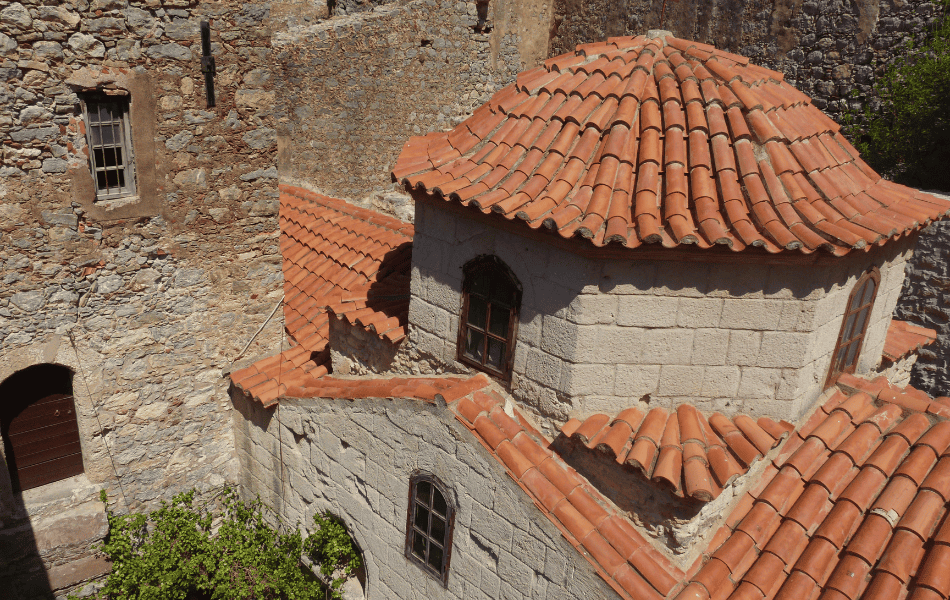
Nestled in the Dodecanese archipelago, Tilos offers a tranquil retreat away from the tourist crowds. With its untouched landscapes, pristine beaches, and rich biodiversity, it’s a haven for nature enthusiasts. Explore the charming village of Megalo Chorio, visit the abandoned monastery of Agios Panteleimonas, and embark on hikes through the verdant valleys to discover hidden waterfalls.
2. Folegandros:

This Cycladic island captivates with its dramatic cliffs, picturesque villages, and a slower pace of life. Wander through the narrow streets of Chora, visit the medieval Kastro, and soak up the panoramic views from the Church of Panagia. With its pristine beaches like Agios Nikolaos and Ambeli, Folegandros offers a serene coastal escape.
3. Kythira:
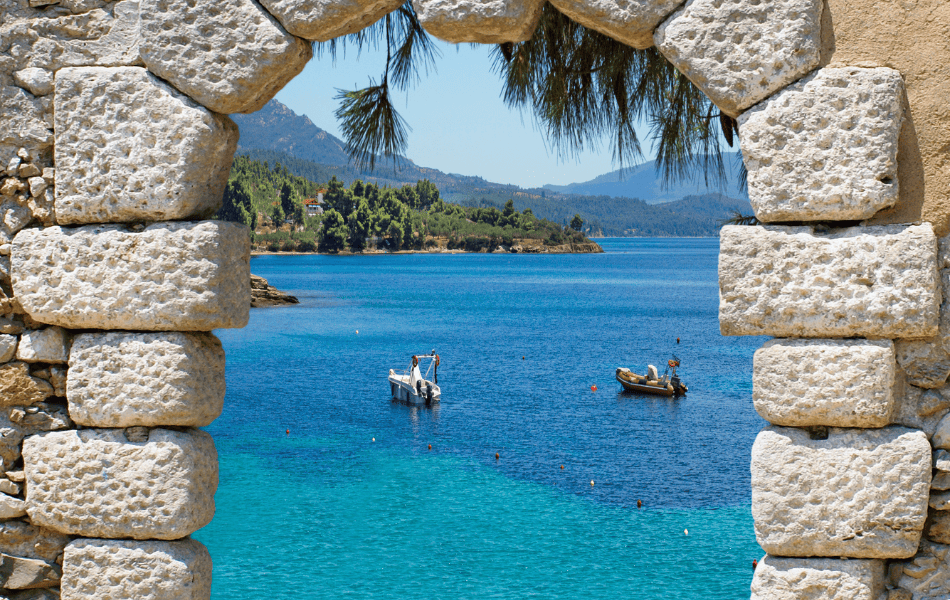
Located at the southern edge of the Peloponnese, Kythira showcases a unique blend of Greek, Venetian, and British influences. Explore the medieval fortress of Chora, hike to the breathtaking waterfall of Fonissa, and discover hidden beaches like Kaladi and Fyri Ammos. Don’t miss the mystical Cave of Agia Sophia and the stunning sunset views from the lighthouse.
4. Amorgos:

Known for its rugged beauty and spiritual aura, Amorgos invites visitors to immerse themselves in its mystical charm. Explore the hilltop village of Chora, visit the impressive Monastery of Panagia Hozoviotissa clinging to the cliffs, and indulge in the rejuvenating waters of the secluded Agia Anna beach. For adventure seekers, hiking the ancient paths of the island offers breathtaking views and a sense of serenity.
5. Kastellorizo:
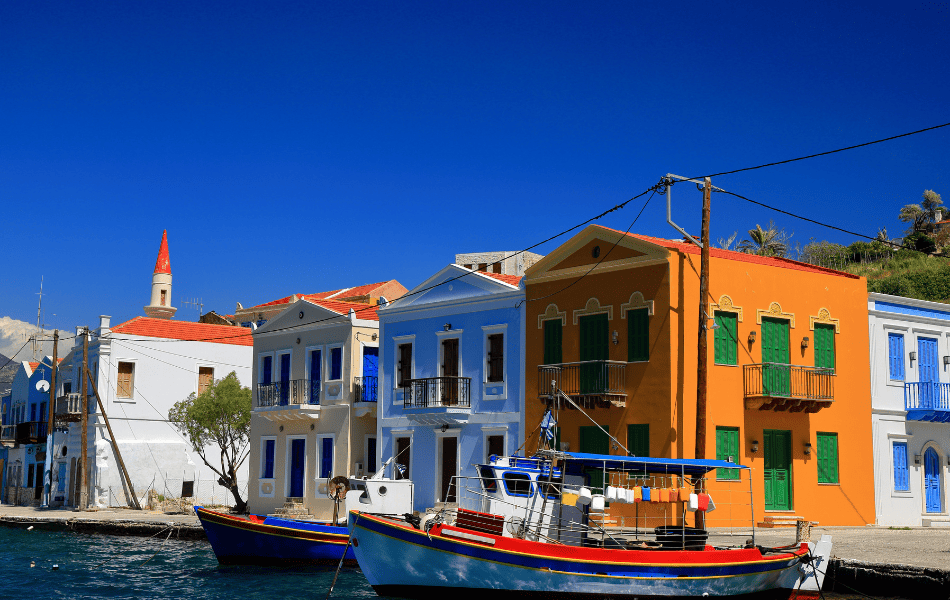
Located in the easternmost part of Greece, Kastellorizo is a hidden gem with vibrant colors and a tranquil atmosphere. Explore the picturesque harbor lined with colorful neoclassical houses, visit the Knights’ Castle, and swim in crystal-clear turquoise waters like the Blue Grotto. Discover the island’s history at the Archaeological Museum and embrace the slow pace of life that makes Kastellorizo a true off-the-beaten-path gem.
6. Symi:
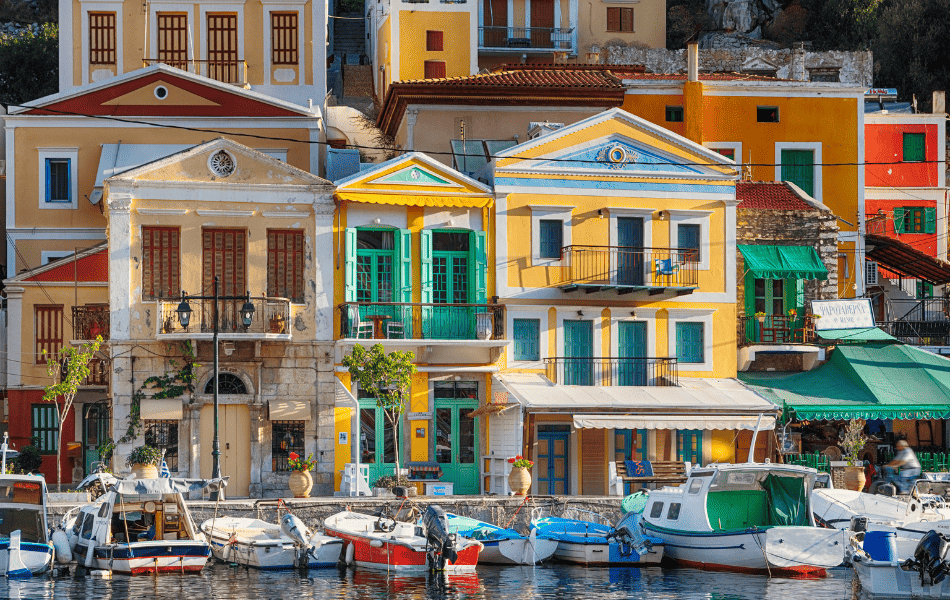
With its colorful neoclassical architecture and picturesque harbor, Symi is a charming island in the Dodecanese. Stroll through the pastel-colored houses of Gialos, visit the historic Monastery of Panormitis, and hike up to the ruins of the Castle of the Knights. Explore the island’s secluded coves, such as Nanou and Agia Marina, and admire the stunning views from the mountain village of Ano Symi.
Astypalea: A hidden gem in the Aegean Sea, Astypalea mesmerizes visitors with its white-washed villages, Byzantine architecture, and stunning landscapes. Explore the hilltop capital of Chora, visit the imposing Castle of Querini, and relax on secluded beaches like Livadi and Kaminakia. Immerse yourself in the island’s authentic atmosphere, savor local delicacies, and witness breathtaking sunsets over the Aegean horizon.
Ancient Secrets Revealed
These lesser-visited ancient ruins and archaeological sites in Greece are windows to a rich historical past. They carry immense historical significance and cultural heritage, revealing the achievements, beliefs, and daily lives of ancient civilizations. By exploring these hidden gems, you can uncover the secrets and marvel at the remarkable architectural and artistic accomplishments of the ancient Greeks.
Ancient Messene
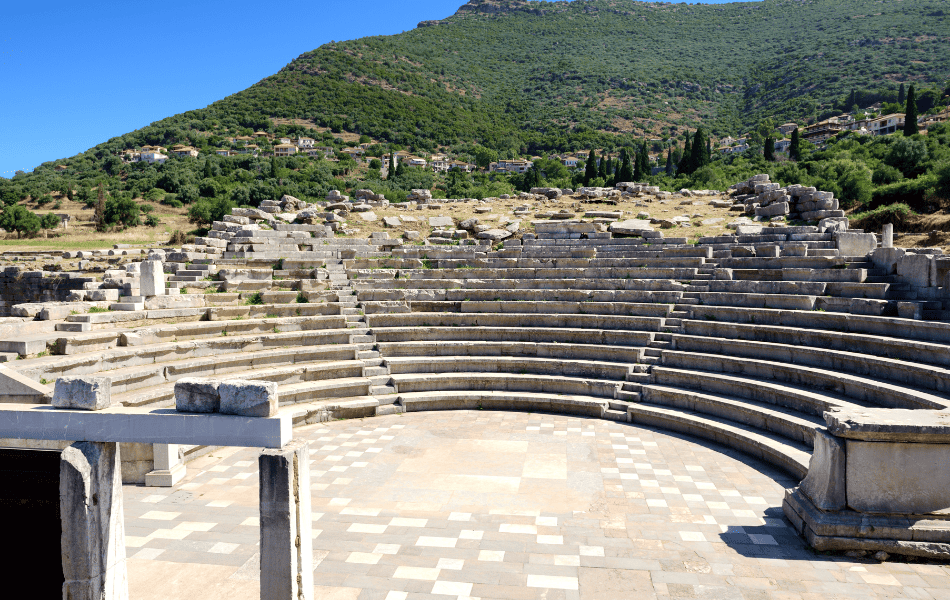
Nestled in the Peloponnese, Ancient Messene stands as a testament to the grandeur of ancient Greece. This well-preserved site offers impressive city walls, a theater, a stadium, and sanctuaries. Step back in time to explore the history of this significant city-state and marvel at its architectural marvels.
Dodona
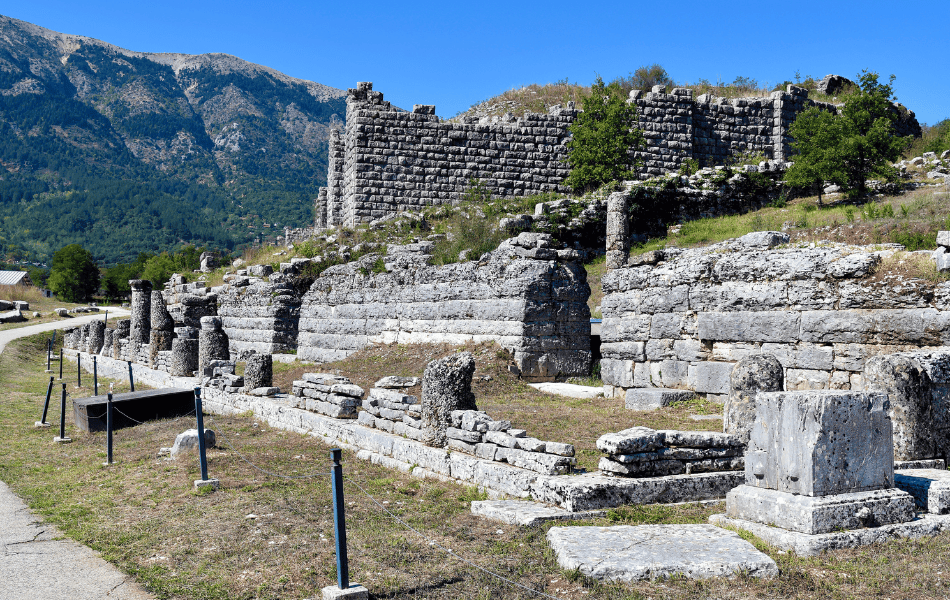
Located in northwestern Greece, Dodona was home to one of the oldest and most revered oracles in ancient Greece. Visit the archaeological site and experience the mystical ambiance of the ancient theater and the sacred oak tree. Dodona played a crucial role in Greek mythology and was considered a major religious and cultural center.
Sanctuary of Asklepios in Epidaurus
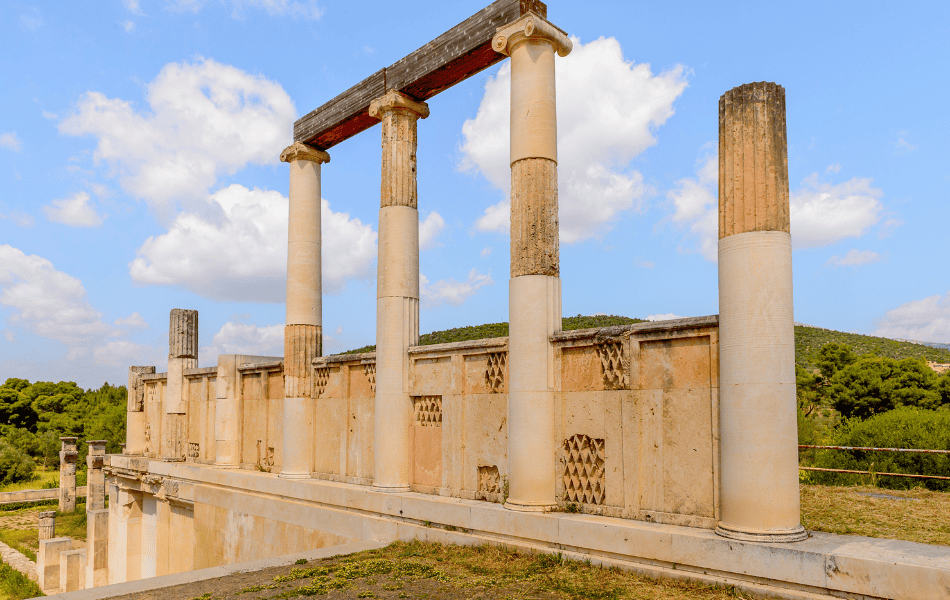
Tucked away in the Peloponnese, the Sanctuary of Asklepios in Epidaurus boasts one of the best-preserved ancient theaters in Greece. This healing center was dedicated to the god of medicine, Asklepios. Marvel at the impressive architecture and acoustics of the theater, and explore the archaeological site, which includes a stadium, baths, and temples.
Ancient Olympia
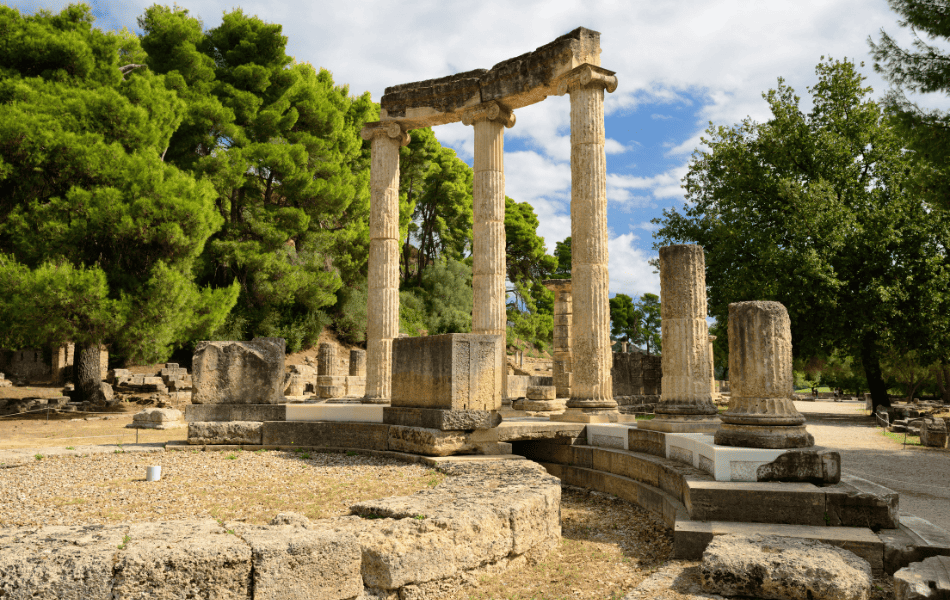
As the birthplace of the Olympic Games, Ancient Olympia holds immense historical significance. Delve into the ruins of this sacred site, where athletes once competed and where the Olympic flame is ceremoniously lit. Explore the Temple of Zeus, the ancient stadium, and the Archaeological Museum to unravel the glory of the Games and the ancient world.
Delos
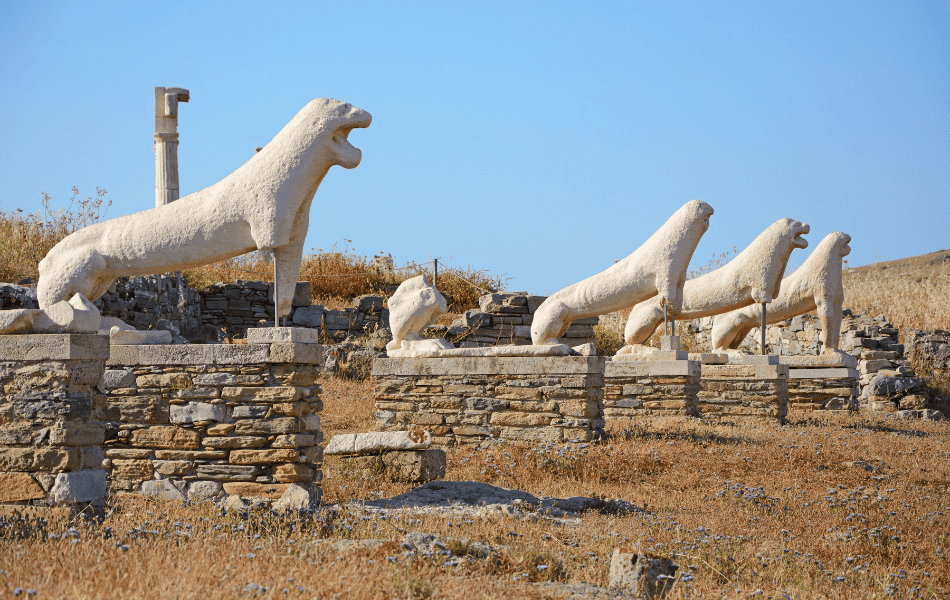
A small island in the Cyclades, Delos boasts an extraordinary archaeological site that is often overlooked. Considered a sacred island in ancient times, it features remarkable ruins, including temples, theaters, and houses. Wander through the Terrace of the Lions, admire the mosaics of the House of Dionysus, and soak in the spiritual aura of this UNESCO World Heritage Site.
Delphi
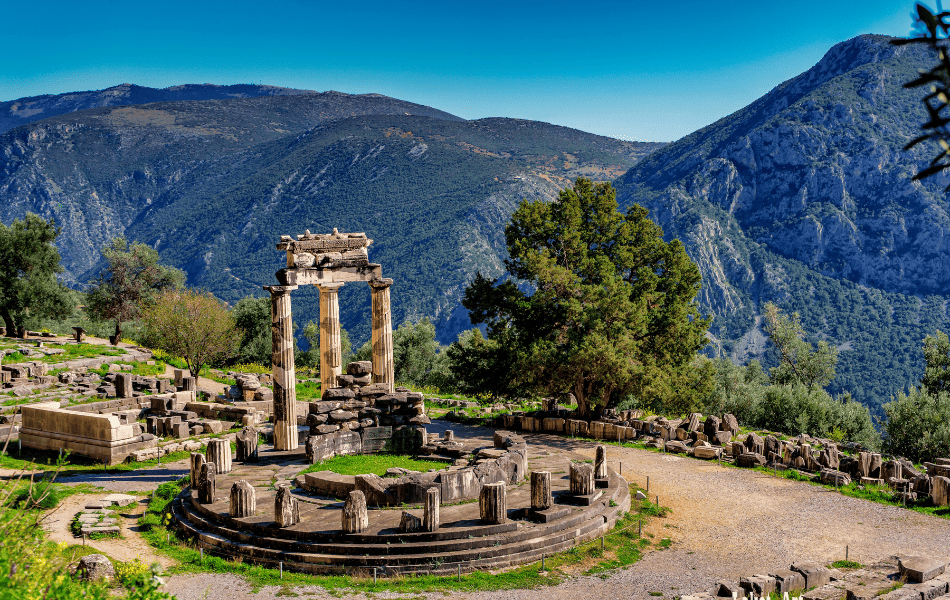
Nestled on the slopes of Mount Parnassus, Delphi was revered as the center of the world in ancient Greek mythology. Visit the Oracle of Delphi and explore the ruins of the Temple of Apollo, the ancient theater, and the Delphi Archaeological Museum. Discover the mystical past of this ancient sanctuary, which attracted pilgrims and seekers of wisdom.
Akrotiri, Santorini
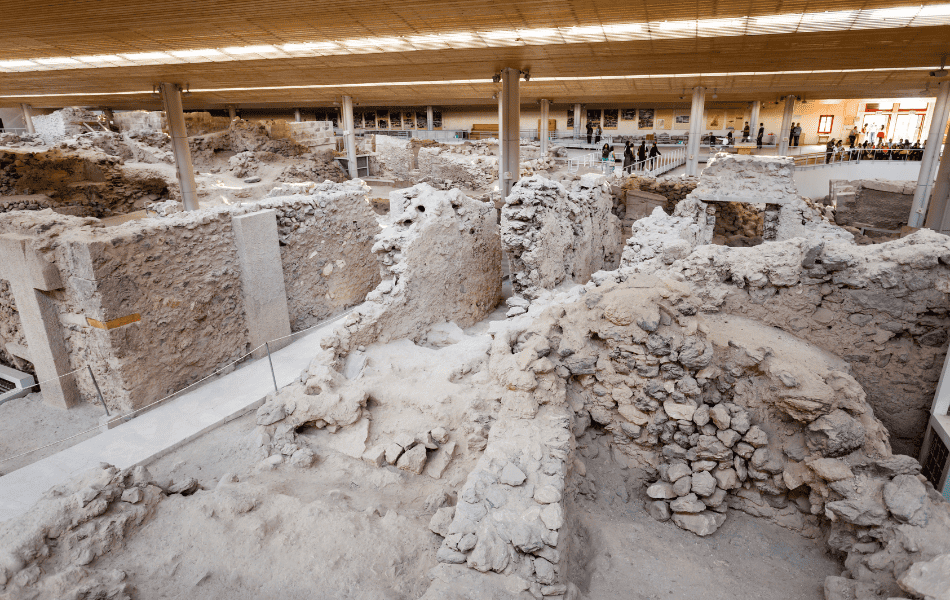
Buried beneath volcanic ash for centuries, Akrotiri on the island of Santorini is a remarkable archaeological site that offers insights into the Minoan civilization. Marvel at the well-preserved ruins of a sophisticated ancient settlement, with multi-story buildings, intricate frescoes, and advanced urban planning. Akrotiri provides a fascinating glimpse into a lost world.
7 Hidden Villages and Mountain Retreats
These hidden villages and mountain retreats in Greece offer a glimpse into the country’s rich cultural heritage and natural beauty. From preserved medieval towns to picturesque mountain hamlets, each destination invites you to discover its unique charm, explore historical sites, engage with local traditions, and enjoy the serene surroundings of Greece’s hidden gems.
1. Nymfaio
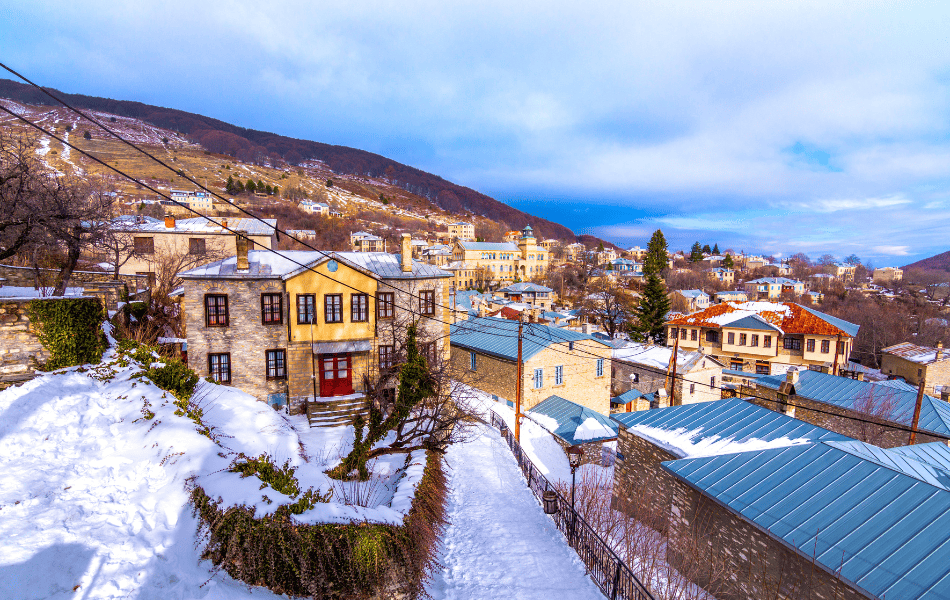
Tucked away in the mountains of northern Greece, Nymfaio is a fairytale-like village renowned for its traditional architecture and untouched beauty. Wander through its cobblestone streets, admire the preserved stone houses, and soak in the serene ambiance of the central square. With its stunning surroundings and proximity to wildlife reserves, Nymfaio is a paradise for nature lovers.
2. Zagorochoria
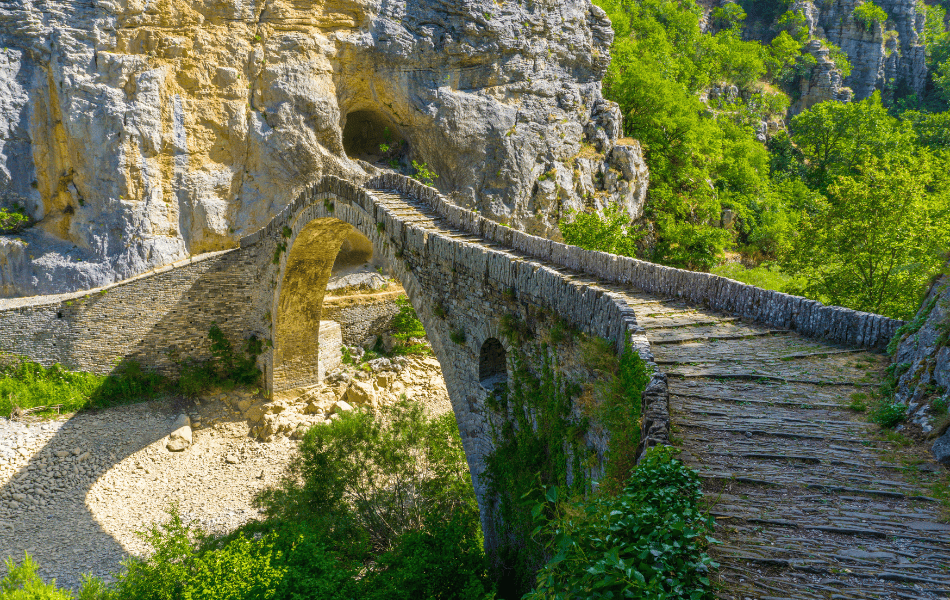
Nestled in the Pindus Mountains, the Zagorochoria region comprises 46 picturesque villages, each with its unique charm. Trek through stone-paved paths, cross elegant arched bridges and marvel at the traditional stone mansions that reflect the region’s rich history. Immerse yourself in the region’s natural wonders, including the breathtaking Vikos Gorge and the pristine Voidomatis River.
3. Monemvasia
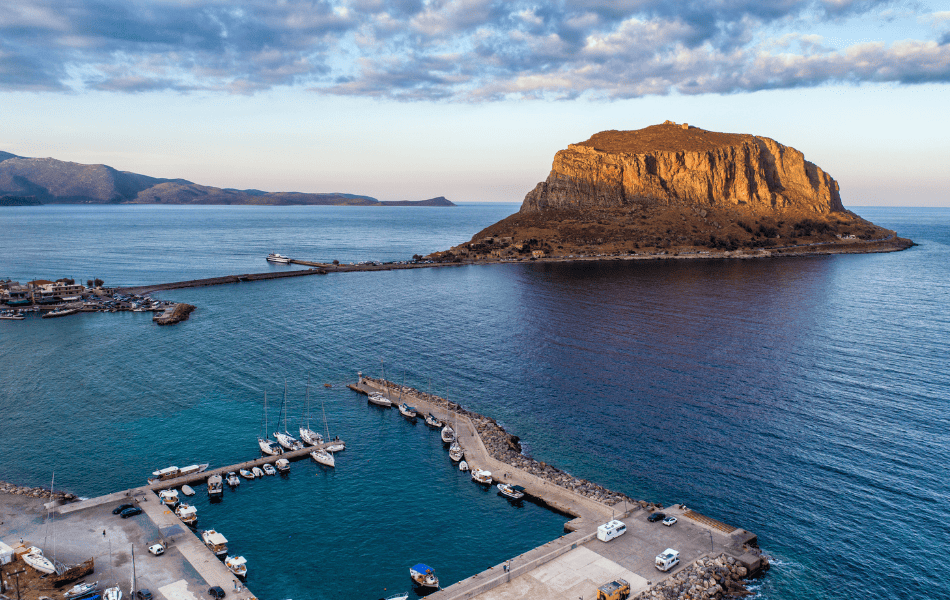
Located on a rocky island off the eastern coast of the Peloponnese, Monemvasia is a hidden medieval gem. Accessible via a narrow causeway, this fortified town transports visitors back in time with its cobbled streets, Byzantine churches, and imposing castle. Explore the labyrinthine alleys, soak in panoramic views from the fortress walls, and discover hidden beaches along the coast.
4. Dimitsana
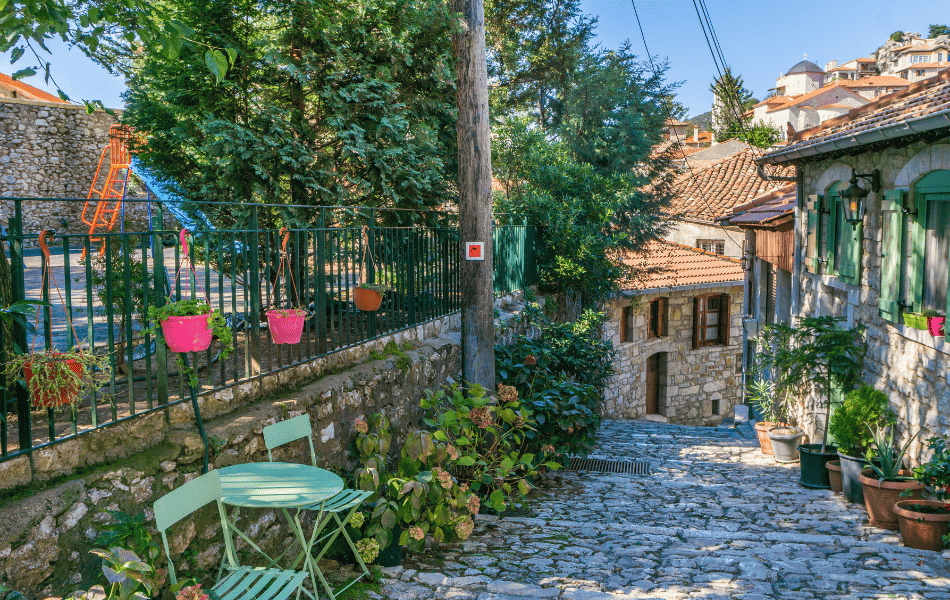
Situated in the heart of the Arcadia region, Dimitsana is a mountainous village known for its rich history and traditional architecture. Explore the open-air Water Power Museum, which showcases the area’s hydraulic traditions, and visit the renowned Library of Dimitsana. Enjoy hiking trails that lead to beautiful monasteries and take in the breathtaking views of the surrounding mountains.
5. Vitsa

Perched on the slopes of Mount Mitsikeli in the Zagori region, Vitsa offers a tranquil mountain retreat. Stroll through its narrow streets lined with stone houses, visit the picturesque central square, and marvel at the 17th-century Monastery of Panagia Vellas. Vitsa is also an excellent starting point for exploring the famous Vikos Gorge and the nearby villages of the Zagori region.
6. Mesta, Chios
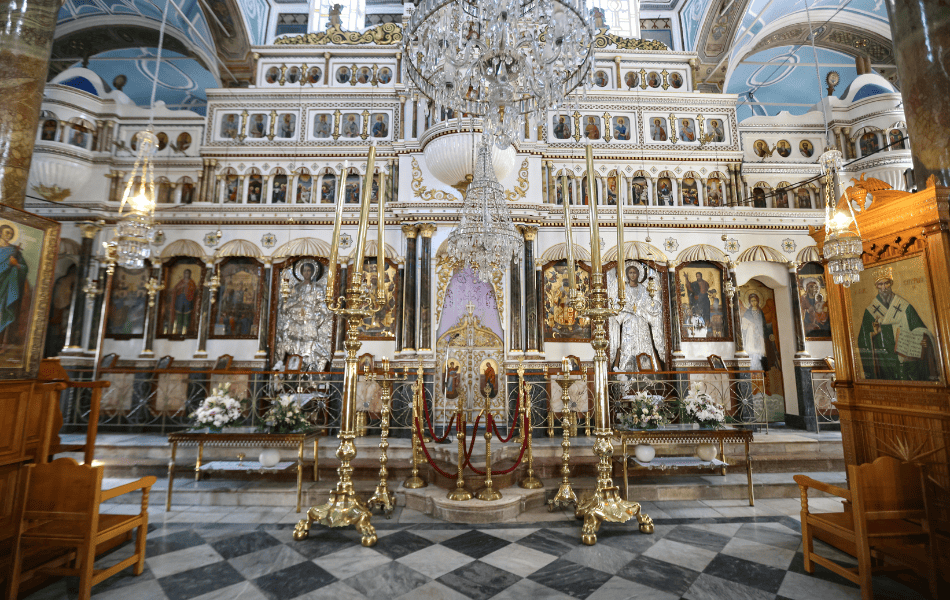
Located on the island of Chios in the Aegean Sea, Mesta is a medieval village characterized by its labyrinthine layout and fortified stone houses. Lose yourself in the maze of narrow streets, visit the central square with its Byzantine church, and admire the impressive architecture that has remained unchanged for centuries. The village also offers easy access to stunning beaches and the renowned Mastiha villages.
7. Olymbos, Karpathos
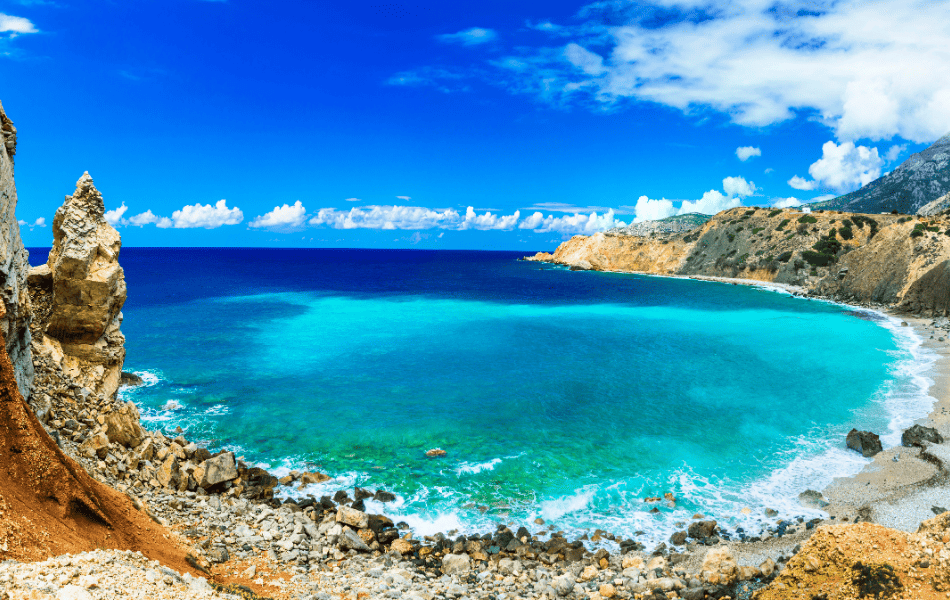
Olymbos is a unique village situated on the island of Karpathos in the Dodecanese. Known for its traditional customs, colorful traditional costumes, and distinctive dialect, it feels like a living museum of Greek folk culture. Explore the village’s winding alleys, visit the Folklore Museum, and witness traditional festivities to immerse yourself in the authentic atmosphere of Olymbos.
Natural Wonders and Outdoor Adventures
These natural wonders and outdoor adventures in Greece showcase the country’s diverse and awe-inspiring landscapes. From magnificent canyons and monasteries perched on cliffs to hidden beaches and soaring mountains, each destination offers a unique experience that allows you to connect with nature, indulge in thrilling activities, and create unforgettable memories in Greece’s remarkable outdoors.
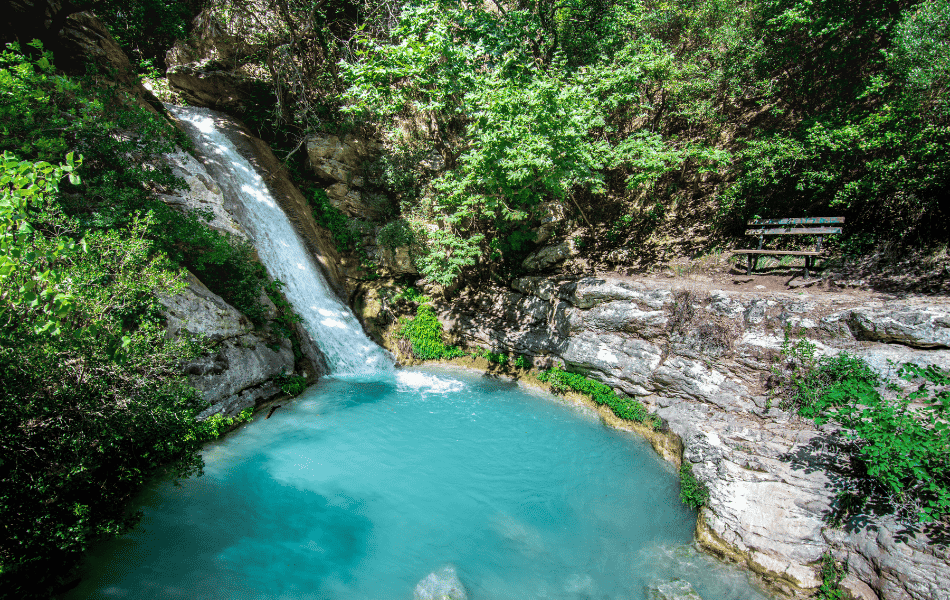
Neda Waterfall
Greece is home to some stunning waterfalls, including the famous Neda Waterfalls in the Peloponnese region. Neda Waterfalls cascade down rocks into crystal-clear pools, surrounded by lush greenery and dramatic landscapes. It’s a hidden gem for nature lovers and offers a refreshing escape into the serene beauty of Greece’s natural wonders.
Samaria Gorge
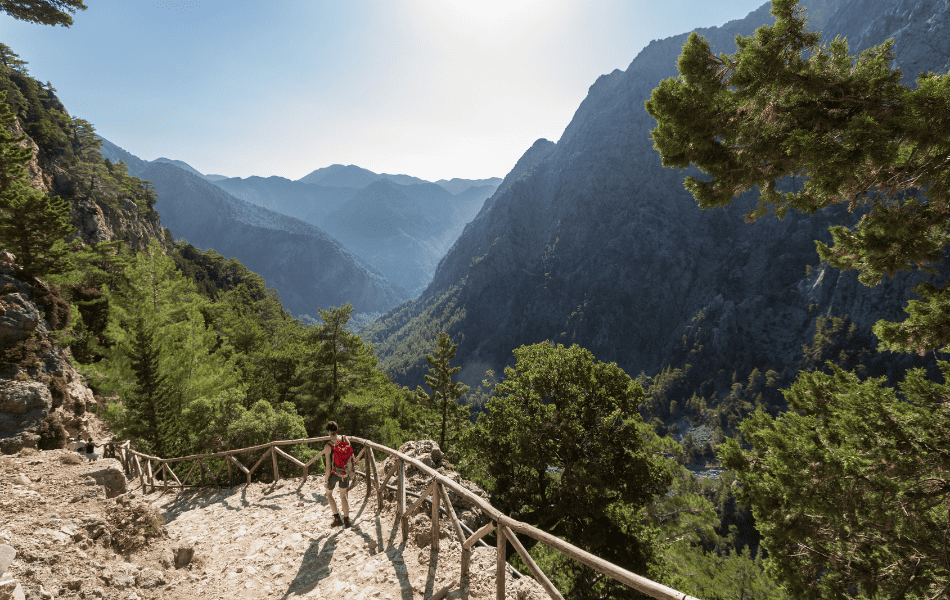
Located in Crete, the Samaria Gorge is one of the longest and most impressive canyons in Europe. Hike through its breathtaking landscapes, pass towering cliffs, and marvel at the narrowest section known as the “Iron Gates.” Along the way, encounter diverse flora and fauna, including the rare Cretan wild goat, and reach the enchanting village of Agia Roumeli, where the gorge meets the sea.
Meteora
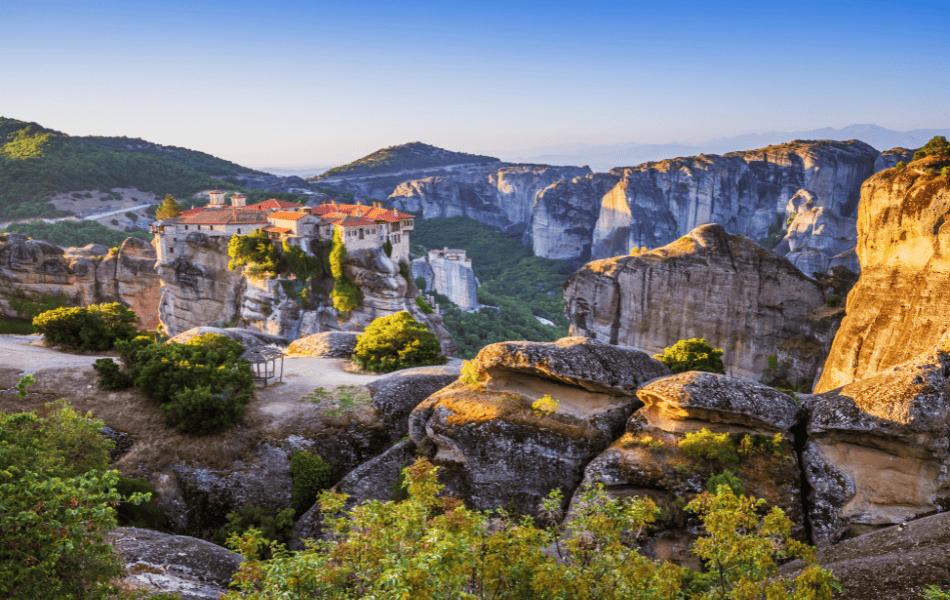
Rising dramatically from the Thessalian plain, Meteora is a UNESCO World Heritage Site renowned for its monasteries perched atop towering rock pillars. Explore this mystical landscape, with its breathtaking views and spiritual ambiance. Visit some of the remaining active monasteries, hike the trails that connect them, and witness stunning sunsets that cast a magical glow over the rugged terrain.
Navagio Beach

Nestled on the island of Zakynthos, Navagio Beach, also known as Shipwreck Beach, is a stunning cove famous for its crystal-clear turquoise waters and the shipwrecked smuggler’s ship that lies ashore. Accessible only by boat, the beach offers a paradise for sunbathing, swimming, and capturing postcard-perfect photographs. If you love chasing beaches, this is one you have to catch!
Vikos Gorge
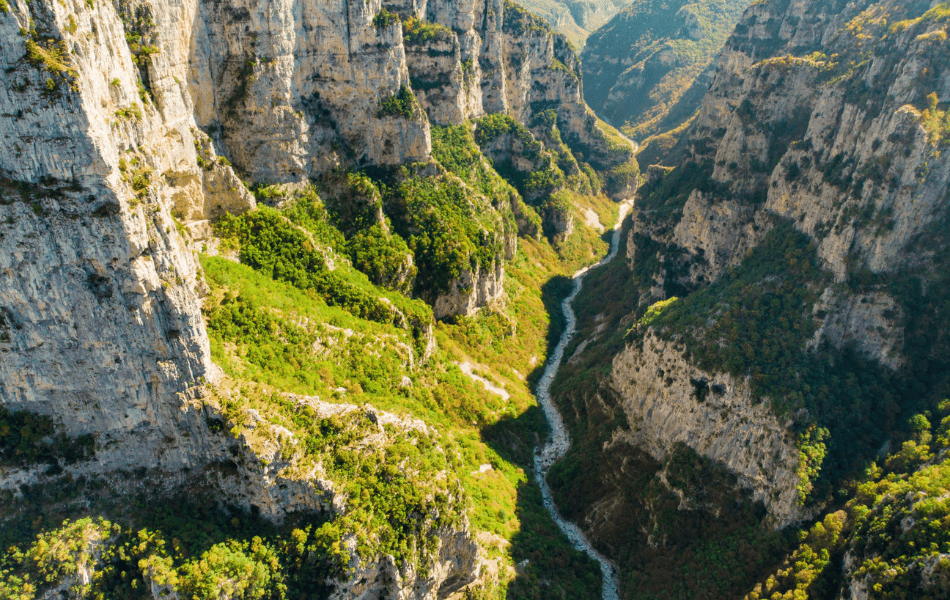
Located in the Zagori region of northern Greece, Vikos Gorge is one of the deepest gorges in the world. Hike through its dramatic landscapes, pass through charming stone villages, and gaze at the breathtaking views from viewpoints like Oxia. The gorge is a paradise for outdoor enthusiasts, offering opportunities for trekking, canyoning, and exploring the untamed wilderness.
Lake Plastiras
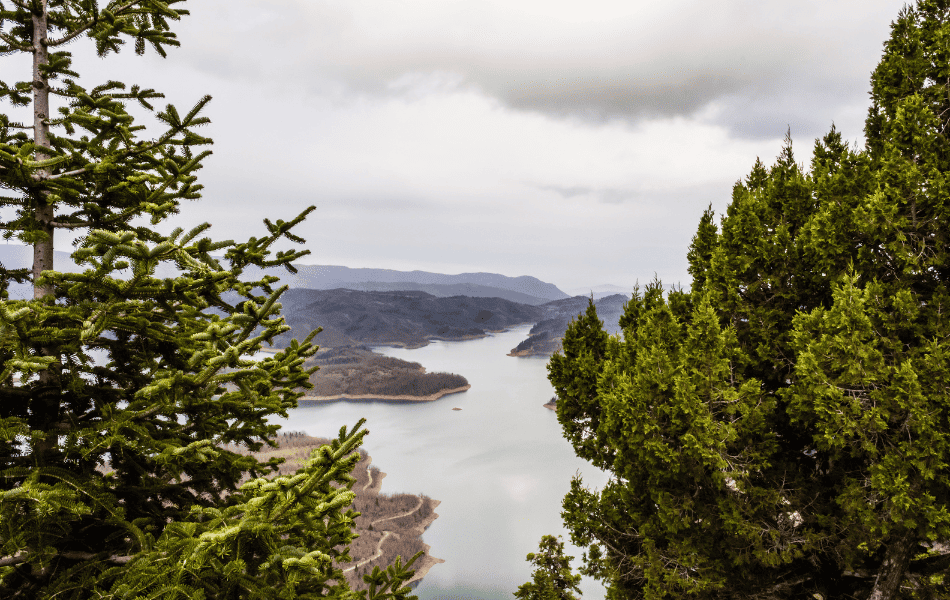
Situated in central Greece, Lake Plastiras is an artificial lake surrounded by lush forests and snow-capped peaks. Experience its tranquility by taking a boat ride, enjoy hiking and mountain biking trails that wind through the surrounding landscape, or simply relax and admire the picturesque scenery. The lake also offers opportunities for fishing and birdwatching.
Mount Olympus

Known as the legendary home of the Greek gods, Mount Olympus stands majestically as the highest mountain in Greece. Embark on an unforgettable hiking adventure, following trails that lead to the summit and immersing yourself in the awe-inspiring alpine landscapes. Discover the diverse flora and fauna, explore ancient paths, and revel in the sense of accomplishment at the mountain’s peak.
Lalaria Beach
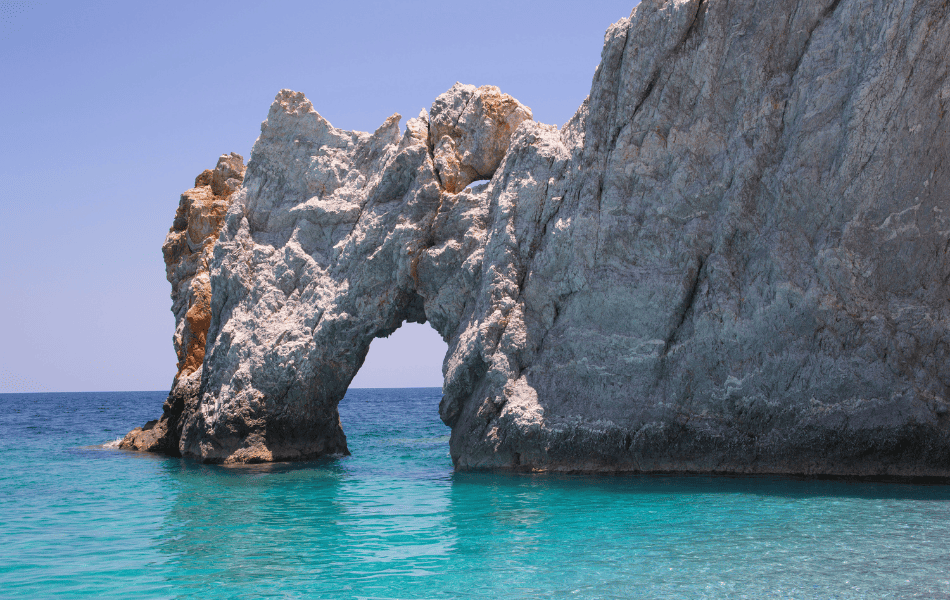
Located on the island of Skiathos, Lalaria Beach is a hidden gem accessible only by boat. Marvel at the unique rock formations, including the famous “Kastro” or arch, and relax on its white pebble shores. The crystal-clear waters invite you to swim, while the breathtaking surroundings create an idyllic atmosphere for a day of exploration.
Connecting with the Local Culture
Greece’s local culture is as vibrant as its ancient history, and connecting with it is a gateway to a deeper understanding of the country’s identity. From engaging with locals to experiencing traditional customs and indulging in culinary delights, there are numerous ways to immerse yourself in Greece’s rich heritage.
Start by exploring traditional villages off the beaten path, where you can witness age-old traditions and craftsmanship. Engage in conversations with locals, who are often warm and welcoming, and learn about their customs and way of life. Participate in traditional festivals, such as Panigiria, where you can dance, feast on local delicacies, and celebrate alongside the locals.
Age-Old Traditions and Craftsmanship Unique to the Greeks
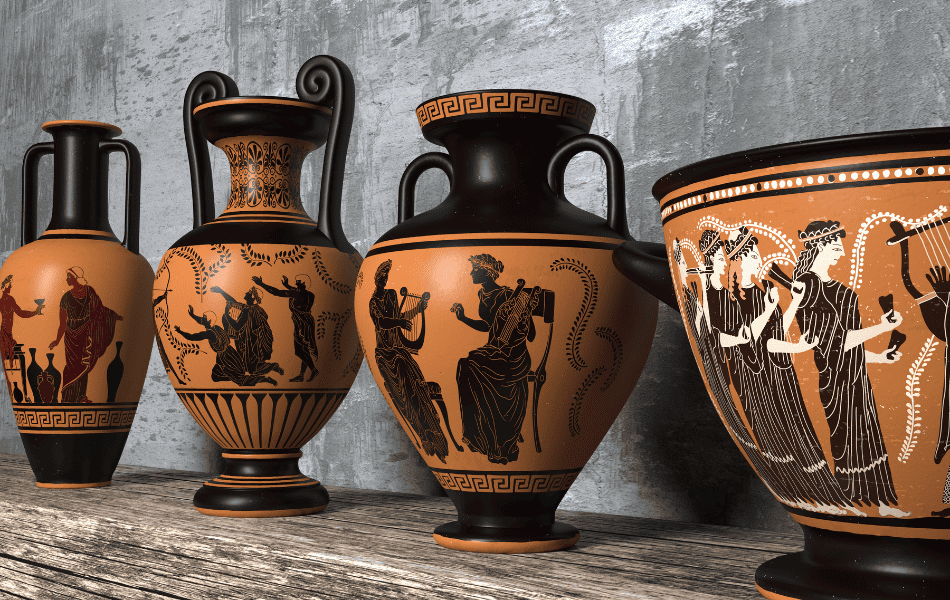
- Pottery Making: Greek pottery has a rich history dating back thousands of years. From the Minoan civilization to Classical Greece, pottery played a significant role in daily life and artistic expression. Traditional pottery techniques, such as wheel-throwing and hand-painting intricate designs, have been passed down through generations, resulting in exquisite vessels, amphorae, and decorative items that reflect Greek aesthetics and mythology.
- Olive Oil Production: Greece has a long-standing tradition of olive oil production, dating back thousands of years. The cultivation of olive trees, the harvesting of olives, and the extraction of olive oil are deeply ingrained in Greek culture. Traditional methods, such as hand-picking olives and pressing them in stone mills, are still practiced today, preserving the authenticity and quality of Greek olive oil, which is renowned for its rich flavor and health benefits.
- Byzantine Iconography: Byzantine iconography is a sacred art form that emerged during the Byzantine Empire and continues to thrive in Greece. This intricate artistic tradition involves the creation of religious icons, painted on wood panels using specific techniques and materials. The icons depict saints, biblical scenes, and religious figures, serving as objects of devotion and spiritual connection for Orthodox Christians. Byzantine iconography requires meticulous craftsmanship and adherence to established guidelines, preserving a unique and revered artistic heritage in Greece.
Unique Culinary Traditions of Greece
Delve into the country’s culinary traditions by taking cooking classes or visiting local markets to taste fresh produce and traditional dishes. Greece’s cuisine is a reflection of its history and regional diversity, and indulging in authentic Greek meals is a delightful way to connect with the local culture. Food tours make a difference to the communities.

- Meze Culture: Greece is known for its vibrant meze culture, where a variety of small plates are shared among friends and family. Meze can include a range of dishes like tzatziki (yogurt and cucumber dip), dolmades (stuffed grape leaves), spanakopita (spinach pie), taramasalata (fish roe dip), and many more. This tradition emphasizes socializing, leisurely dining, and savoring a diverse array of flavors.
- Souvlaki and Gyro: Souvlaki and gyro are iconic Greek street foods. Souvlaki typically consists of skewered and grilled meat, often marinated in olive oil, lemon juice, and herbs, while gyro features thinly sliced, seasoned meat (traditionally pork) cooked on a vertical rotisserie. These flavorful meats are usually wrapped in pita bread and accompanied by fresh vegetables, tzatziki sauce, and fries. Souvlaki and gyro are beloved fast food options that offer a taste of Greece on the go.
- Baklava: Baklava is a sweet pastry that holds a special place in Greek cuisine. It consists of layers of delicate phyllo dough filled with a mixture of ground nuts (typically walnuts or pistachios), sugar, and fragrant spices like cinnamon and cloves. After baking, it is soaked in a syrup made of honey, sugar, and lemon juice, creating a rich, sweet, and sticky treat. Baklava showcases the Greeks’ skill in working with phyllo dough and their love for indulgent desserts.
These culinary traditions reflect the Greek passion for food, socializing, and the celebration of flavors. Whether enjoying meze, savoring souvlaki and gyro, or indulging in the sweetness of baklava, these unique Greek culinary traditions offer a delightful experience that is deeply rooted in the country’s culture and history.
Why taking cooking classes is so special in Greece
Taking cooking classes in Greece is a truly special experience. It allows you to delve into the heart of Greek cuisine, learning the secrets of traditional recipes handed down through generations. From picking fresh ingredients in local markets to mastering the art of Greek flavors, these classes offer an immersive and delicious journey into Greek culture.
For recommendations browse through the list below:
- Small-Group Athens Cooking Class & Dinner
- Cooking Class in Athens Including Rooftop Dinner with Acropolis View
- Naxos: Half-day cooking class at Basiliko
Art and music also play a significant role in Greek culture. Attend live performances of traditional music, often accompanied by vibrant folk dances, or explore contemporary art galleries and museums showcasing the works of Greek artists.

Traditional Music: Rembetiko
Rembetiko is a distinct genre of Greek music that originated in the early 20th century. It emerged from the urban working-class neighborhoods of Athens and Piraeus, reflecting the struggles and joys of everyday life. Rembetiko combines elements of Eastern and Western music, incorporating instruments such as the bouzouki, baglama, and guitar. It is characterized by passionate vocals, intricate melodies, and poignant lyrics, often touching upon themes of love, loss, and the realities of marginalized communities. Rembetiko has a deep cultural significance and remains popular, both for its nostalgic value and as a symbol of Greek musical heritage.
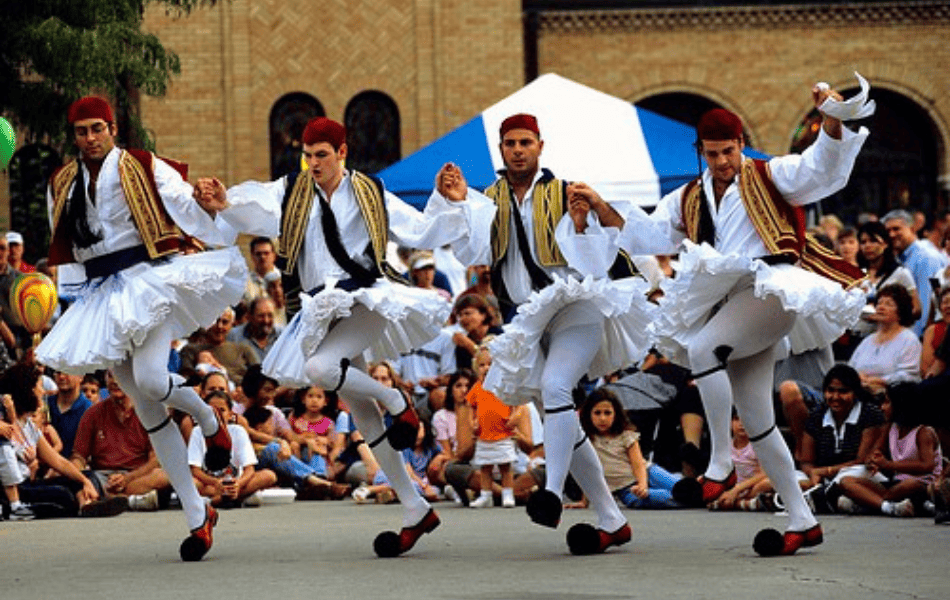
Folk Dance: Kalamatianos
Kalamatianos is a lively folk dance from the region of Kalamata in southern Greece. It is a popular dance performed at celebratory events and weddings. The dance involves a group of participants forming a circle, holding hands or placing hands on each other’s shoulders, and moving in a synchronized manner to the rhythm of the music. The steps are lively and energetic, incorporating quick footwork and graceful arm movements. Kalamatianos is known for its joyful atmosphere, fostering a sense of community and celebration. It represents the lively spirit and rich cultural traditions of Greece.
Contemporary Art Gallery: The Alex Mylona Museum in Athens

Nestled in the heart of Athens, the Alex Mylona Museum is a hidden gem showcasing contemporary art by Greek artists. Founded in 2004, this unique gallery is located in a converted industrial building, adding an edgy and unconventional touch to the artworks it houses. The museum focuses on contemporary visual arts, including painting, sculpture, installations, and multimedia exhibits.
The Alex Mylona Museum serves as a platform for emerging and established Greek artists to display their innovative and thought-provoking creations. Its dynamic exhibitions feature a diverse range of artistic styles and themes, reflecting the evolving artistic landscape of Greece. From abstract compositions to social commentary and explorations of identity, visitors can immerse themselves in the contemporary art scene and engage with the visions of talented Greek artists.
Museum Showcasing Greek Artists: The Municipal Gallery of Rhodes
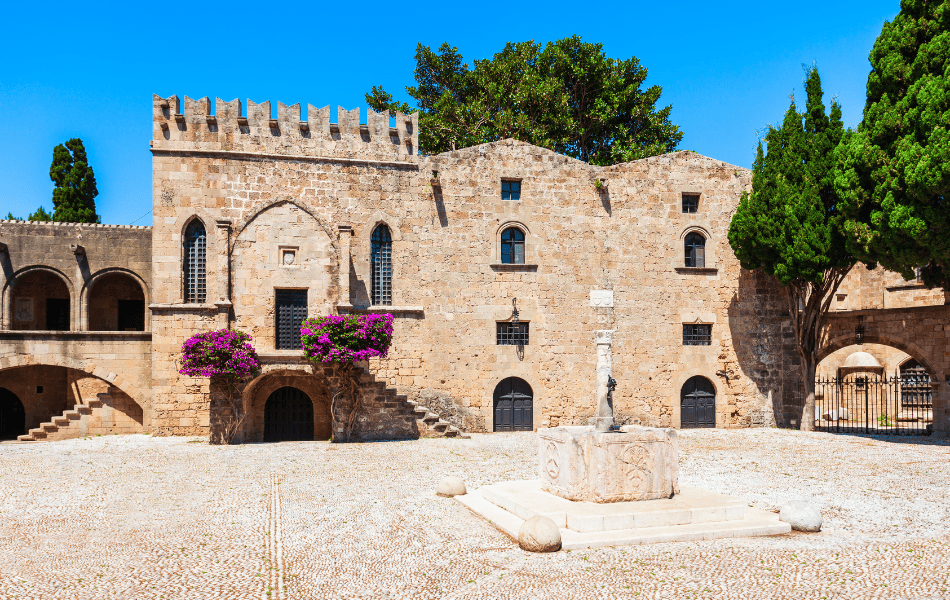
Situated on the picturesque island of Rhodes, the Municipal Gallery of Rhodes is a hidden treasure that celebrates the works of Greek artists. Housed in a renovated medieval building in the heart of Rhodes Town, this museum offers a captivating journey through the history of Greek art.
The Municipal Gallery of Rhodes boasts an impressive collection of paintings, sculptures, and other artworks spanning different periods and artistic movements. Visitors can admire the creations of renowned Greek artists, both past and present, and gain insights into the evolution of Greek art over time. From traditional landscapes and portraits to contemporary expressions, the museum showcases the breadth and depth of artistic talent in Greece.
While exploring the Municipal Gallery of Rhodes, visitors can also appreciate the unique architectural features of the building, which add a touch of charm and historical significance to the museum experience. It is an enriching cultural destination where visitors can connect with Greek art and immerse themselves in the artistic heritage of Rhodes.
Practical Tips for Exploring Off the Beaten Path
By following these practical tips, you can embark on a rewarding journey through off-the-beaten-path destinations in Greece, immersing yourself in the local culture, discovering hidden treasures, and creating unforgettable memories.
- Research and Planning: Before embarking on your off-the-beaten-path adventure in Greece, conduct a thorough research about the destinations you plan to visit. Look for information on attractions, transportation options, and accommodation availability. This will help you make informed decisions and ensure a smoother experience.
- Flexible Itinerary: When exploring lesser-known destinations, it’s advisable to have a flexible itinerary. Allow for extra time in each location, as you may discover hidden gems along the way or want to spend more time in a particular place that captures your interest.
- Transportation Options: Public transportation might be limited in remote areas, so consider renting a car to have more flexibility and accessibility. Alternatively, you can use local buses or hire a taxi. Keep in mind that some areas might not have well-connected transportation networks, so plan accordingly.
- Off-Peak Travel: Consider traveling during the shoulder seasons (spring and autumn) to avoid crowds and secure better deals on accommodations. Visiting popular attractions early in the morning or late in the afternoon can also help you avoid peak hours.
- Homestays and Guesthouses: Opt for accommodations such as homestays, guesthouses, or boutique hotels in smaller villages and towns. These options not only provide a more authentic experience but also support the local economy.
- Engage with Locals: One of the highlights of exploring off-the-beaten-path destinations is the opportunity to connect with locals. Engage in conversations, ask for recommendations, and immerse yourself in the local culture. Locals often have invaluable insights and can lead you to hidden gems that may not be in guidebooks.
- Pack Essentials: When venturing into remote areas, ensure you have essentials such as water, snacks, sunscreen, insect repellent, comfortable walking shoes, and a map or GPS device. Some destinations may have limited amenities, so it’s best to be prepared.
- Respect the Environment and Culture: As you explore lesser-known destinations, be mindful of your impact on the environment and local communities. Respect local customs, traditions, and natural habitats. Leave no trace behind and adhere to any rules or guidelines provided at archaeological sites or protected areas.
Conclusion
In conclusion, Greece’s off-the-beaten-path destinations offer a world of enchantment and discovery. From ancient ruins to hidden villages, and natural wonders to engaging with the local culture, Greece unveils its secrets to those who dare to venture beyond the tourist hotspots. Embrace the unknown, forge your own path, and unlock the true essence of Greece—a land of rich heritage, breathtaking landscapes, and extraordinary experiences that will leave an indelible mark on your soul.
Recent Posts
Discover insider tips to find cheap flights from the UK, save on easyJet, Ryanair & BA, and score the best weekend and last-minute deals. Why You’re Paying Too Much for Flights Most UK...
Discover the sounds of travel, from laughing kookaburras to market chatter, church bells to ocean waves - a journey heard as much as seen. It always starts with a sound. The other day, walking...

